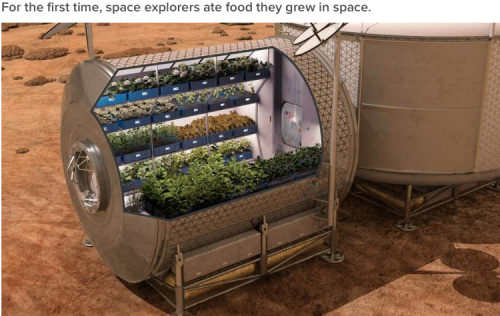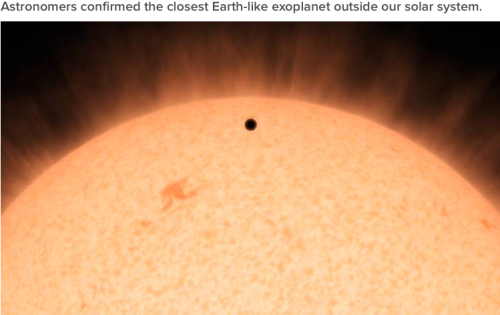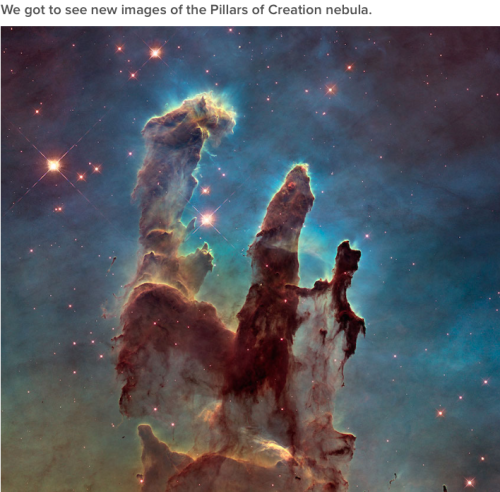Dust Band Around The Nucleus Of “Black Eye Galaxy” M64

Dust Band Around the Nucleus of “Black Eye Galaxy” M64
More Posts from Space-m17-blog and Others

(3 June 1965) — Overall view of the Mission Control Center in Houston, Texas, during the early hours of the Gemini-Titan 4 spaceflight. Photo credit: NASA










If you couldn’t tell already, NASA is having a great year. From Pluto to food grown in space, even in the face of budget cuts, the nation’s space agency had some stellar highlights. Most mysteriously of all, a spacecraft found two eerily bright lights on a distant dwarf planet.




The first two images are tesseracts and the second two are 4D spheres. 1 Dimension: in a universe with one dimension, particles can only move in a line so from left to right not up and down. _____________________________
2 Dimensions: this is made up of an infinite amount of 1D universe and particles would be able to to move in two dimensions, up down left and right. Now if there was an organism living in a 2 dimensional it would see things in 1 dimension just like we see things in 2 dimensions and our brain is what is able to interpret depth by using two eyes and our brain. When we hold our finger in front of our face and move it, we can see that it appears to have moved relative to the background. Our brains see this difference and this allows us to estimate how far away they are. In a 2D universe there would be no background as such to see the “finger” moving against so it would be seen in 1D although it’s impossible to visualise anything in 1 dimension.
3 Dimensions: we live in 3 spatial dimensions in our universe which is made up of an infinite amount of 2D universes. We see things in 2 dimensions. A common misconception is that time is the 4th dimension but it doesn’t really make sense because it is present in every spatial dimension.
4 Dimensions: this is almost impossible to try and visualise. There are some people who claim they can think in 4 and even more dimensions. Now, a 4th dimensional organism would see things in 3 dimensions. If they came to our universe then they would be seeing absolutely every line of every shape but it wouldn’t be possible for a 4D being to like in 3D, it would be like us living in 2D. Above I have some 4D shapes to give you an idea of how we can represent them. It’s better to watch the inks though.
http://youtu.be/-x4P65EKjt0 http://youtu.be/5BF-ygCbmD8
Hello! I'm a person, and I find physics (specifically astrophysics) to be incredibly interesting, and I'd like to know more about it. Have any idea on what I should read/watch to get more educated on the subject? I don't know where to start ^^".
Well I get a lot of my updates in the science world from here, http://www.sciencedaily.com/news/space_time/astrophysics/ just look under the astrophysics section then when you get to understand some of the key concepts the look up papers on science direct and google scholar for the best free papers :)









An Adaptable Species: Part 1 of 4 Episode 11: The Immortals, Cosmos: A SpaceTime Odyssey
Today marks the 40th anniversary for the launch of the Viking 1 lander/orbiter to Mars in 1975, which set the stage - err, launch pads - for subsequent flyby, orbiter, lander, and rover missions.
Although some of these missions are marked as “failed” attempts, an engineer or flight controller would dismiss this classification, as data from every mission parleyed information for the next. Failures? No. More like “growing pains” in our spacefaring adolescence.
The year 2015 marks another noteworthy anniversary to which the Viking program laid the foundation for our curiosity and present trajectory for NASA’s #JourneyToMars.
This wonderfully produced video from NASA’s Jet Propulsion Laboratory (JPL) conveys the breadth of vision and the excitement from, among every aspect of each robotic mission, successfully received data!
Enjoy, and continue the journey with us as we work to preserve the legacy of the Viking program with The Viking Mars Missions Education and Preservation Project, the #FirstOnMars!

Give support to this project

Jump With Feeling!

A photo of Saturn. Took by Cassini with COISS on May 22, 2008 at 13:31:01. Detail page on OPUS database.

Introducing Ethiopia’s just born Space research programme
High above the crowded streets of Addis Ababa, among fields where farmers lead oxen dragging wooden ploughs, sits Ethiopia’s space programme.
Perched at the top of the 3200m-high Mount Entoto, two metal domes house telescopes, each a metre in diameter. In operation for only a few months, they have propelled Ethiopia into an elite club of African countries to have embarked on a space programme.
Its programme is aimed at giving the country a technological boost that will aid its already rapid development.
“Science is part of any development cycle,” says Abinet Ezra, spokesman for the Ethiopian Space Science Society. “Without science and technology nothing can be achieved.
“Our main priority is to inspire the young generation to be involved in science and technology.”
The society, funded by Ethiopian-Saudi business tycoon Mohammed Alamoudi, was set up in 2004 to promote astronomy. But its supporters have had a tough ride setting up the space programme.
For the past decade, a handful of enthusiasts - including Solomon Belay, director of the observatory and a professor of astrophysics - battled with the authorities to convince them that, in a country that is still one of the poorest in the world, where malnutrition is still a threat, the exploration of space is not a luxury. Ethiopian strongman Meles Zenawi, who died in 2012, considered them dreamers.
“People said we were crazy,” says Belay.
The R39-million space observatory is, above all, a symbol. The site at Entoto, often hidden by clouds during the rainy season and close to the lights of Addis Ababa, struggles to compete with the world’s major observatories, including the far larger Southern African Large Telescope in South Africa.
But Ethiopia has plans, including to build a far more powerful observatory in the northern mountains around Lalibela, far from city lights.
The government hopes to launch a national space agency - and to put an Ethiopian satellite in orbit within five years, for the monitoring of farmland and to boost communications.
“We are using space applications in everyday activities, for mobile phones, weather - space applications are fundamental,” says Kelali Adhana, the International Astronomical Union chief for East Africa, based in Ethiopia. “We cannot postpone it, otherwise we allow ourselves to live in poverty.”
At Ethiopia’s Institute of Technology, in the northern town of Mekelle, scientists plan to test the first Ethiopian rocket to go more than 30km, although that is still far from the 100km frontier beyond which the Earth’s atmosphere gives way to space proper.
-
 blue-glass-doll-blog liked this · 6 years ago
blue-glass-doll-blog liked this · 6 years ago -
 lightcycler liked this · 6 years ago
lightcycler liked this · 6 years ago -
 glitchtrial001-blog liked this · 6 years ago
glitchtrial001-blog liked this · 6 years ago -
 jjandjim liked this · 6 years ago
jjandjim liked this · 6 years ago -
 genocider-syo-is-still-my-queen liked this · 6 years ago
genocider-syo-is-still-my-queen liked this · 6 years ago -
 pedromasari liked this · 6 years ago
pedromasari liked this · 6 years ago -
 sharkspaceengine liked this · 6 years ago
sharkspaceengine liked this · 6 years ago -
 radiodogblog liked this · 6 years ago
radiodogblog liked this · 6 years ago -
 ajc18615425 liked this · 6 years ago
ajc18615425 liked this · 6 years ago -
 stars-are-weird liked this · 6 years ago
stars-are-weird liked this · 6 years ago -
 sunshineisellipsoid liked this · 6 years ago
sunshineisellipsoid liked this · 6 years ago -
 brieflydarkobject liked this · 6 years ago
brieflydarkobject liked this · 6 years ago -
 cannibaldotcom liked this · 6 years ago
cannibaldotcom liked this · 6 years ago -
 tiredskies-sadeyes reblogged this · 6 years ago
tiredskies-sadeyes reblogged this · 6 years ago -
 tiredskies-sadeyes liked this · 6 years ago
tiredskies-sadeyes liked this · 6 years ago -
 rebel-grl-in-paradise reblogged this · 6 years ago
rebel-grl-in-paradise reblogged this · 6 years ago -
 theconfessionsofmyclosetedself reblogged this · 6 years ago
theconfessionsofmyclosetedself reblogged this · 6 years ago -
 beirahagstorm reblogged this · 6 years ago
beirahagstorm reblogged this · 6 years ago -
 beirahagstorm liked this · 6 years ago
beirahagstorm liked this · 6 years ago -
 pixiekotic reblogged this · 6 years ago
pixiekotic reblogged this · 6 years ago -
 dxbaby reblogged this · 6 years ago
dxbaby reblogged this · 6 years ago -
 broseph-keller liked this · 7 years ago
broseph-keller liked this · 7 years ago -
 slywind reblogged this · 7 years ago
slywind reblogged this · 7 years ago -
 etceterodactyl reblogged this · 7 years ago
etceterodactyl reblogged this · 7 years ago -
 zsgworldopen-blog liked this · 7 years ago
zsgworldopen-blog liked this · 7 years ago -
 failure-at-being-respectable liked this · 8 years ago
failure-at-being-respectable liked this · 8 years ago -
 simplegirlwithwildideas reblogged this · 9 years ago
simplegirlwithwildideas reblogged this · 9 years ago -
 corruptedtacos reblogged this · 9 years ago
corruptedtacos reblogged this · 9 years ago -
 richardstaff reblogged this · 9 years ago
richardstaff reblogged this · 9 years ago -
 richardstaff liked this · 9 years ago
richardstaff liked this · 9 years ago -
 cynthiastephanie reblogged this · 9 years ago
cynthiastephanie reblogged this · 9 years ago -
 i-am-a-fucking-nerd liked this · 9 years ago
i-am-a-fucking-nerd liked this · 9 years ago -
 lifeisjustfunandgames reblogged this · 9 years ago
lifeisjustfunandgames reblogged this · 9 years ago -
 criekids liked this · 9 years ago
criekids liked this · 9 years ago -
 xmuffledscreamsx liked this · 9 years ago
xmuffledscreamsx liked this · 9 years ago -
 papaabsurd reblogged this · 9 years ago
papaabsurd reblogged this · 9 years ago -
 phintys reblogged this · 9 years ago
phintys reblogged this · 9 years ago -
 valley0f0urthoughts liked this · 9 years ago
valley0f0urthoughts liked this · 9 years ago -
 valley0f0urthoughts reblogged this · 9 years ago
valley0f0urthoughts reblogged this · 9 years ago -
 sneesnoop reblogged this · 9 years ago
sneesnoop reblogged this · 9 years ago
I love space. I've been to space camp in Huntsville Alabama and I am planning on going every summer. I look forward to be an astronaut for nasa on the sls that is planned to be launched 2018. And the manned mission 2030. So yeah I won't let anything get in my way.
138 posts